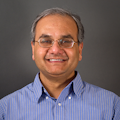Amit Acharya, Ph.D.
Professor, Carnegie Mellon University
Amit Acharya is a professor in the Department of Civil and Environmental Engineering at Carnegie Mellon University and a member of the university’s Mechanics, Materials, and Computing research group. He is an engineer by training with expertise in continuum mechanics, theoretical materials science and applied mathematics.
During his fellowship, Acharnya will work with his mentor Ambar Sengupta of the University of Connecticut. They plan to develop the mathematical background to establish a branch of mathematical gauge theory directly adapted to studying the dynamics and collective behavior of topological defects called dislocations and disclinations in nonlinear elastic solids. Their goal is to study topological defect dynamics in elasticity by path integral methods (at least in the finite-dimensional approximation) to understand its statistical properties, and thus hopefully shed light on the plasticity of crystalline solids — a scientifically intricate macroscopic phenomenon of great technological importance.